Site NE36
Property: Rutherglen Research Institute.
Paddock #: 10
Australian Soil Classification: Bleached-Sodic, Eutrophic, Yellow DERMOSOL
Northcote Factual Key: Gn 4
General Landscape Description: Higher part of plain.
Soil Mapping Unit: Unit 1 - a complex with Rutherglen Loam (brown phase) and varying proportions of normal phase, Types D and A.
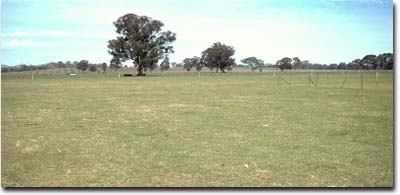 Site NE36 Landscape |
Soil Profile Morphology:
| Surface Soil | 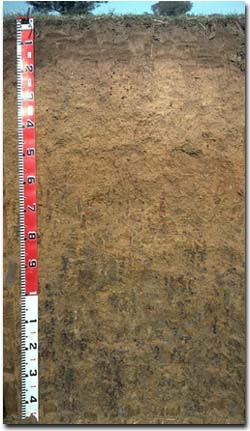 Site NE36 Profile | ||
| A1 | 0-18 cm | Dark brown (7.5YR4/4); light fine sandy clay loam; weak to moderate coarse blocky structure; weak consistence moist; pH 5.5; abrupt change to: | |
| A2 | 18-30 cm | Strong brown (7.5YR5/6) conspicuously bleached (7.5YR7/4d); fine sandy clay loam; weak coarse blocky structure; strong consistence dry; contains a few (10%) ferromanganiferous and manganese concretions (2-10 mm size) and manganese stains; pH 5.3; clear change to: | |
| Subsoil | |||
| B21 | 30-45 cm | Brownish yellow (10YR6/6); light clay; weak to moderate medium polyhedral structure; strong consistence dry; contains a few (10%) ferromanganiferous concretions (2-10 mm size) and a few (5%) angular quartz fragments (4 mm average size); pH 6.2; clear change to: | |
| B22 | 45-60 cm | Brownish yellow (10YR6/8) with red (10R4/8) mottles; light medium clay; moderate medium, parting to moderate fine polyhedral structure, strong consistence dry; contains a few (5%) ferromanganiferous concretions (3-5 mm size); and a few (5%) angular quartz fragments (3 mm average size); pH 6.5: | |
| B23 | 60-90 cm | Brownish yellow (10YR6/6) with red (10R4/8) mottles; light medium clay; moderate to strong medium polyhedral, parting to fine polyhedral structure; very firm consistence moderately moist; contains very few (2%) ferromanganiferous nodules, a few (5%) manganiferous stains, and angular quartz fragments (2 mm average size); pH 6.7; clear change to: | |
| B24 | 90-120 cm | Yellowish brown (10YR5/4) with brownish yellow (10YR6/8) and red (10R4/8) mottles; light medium clay; moderate to strong coarse prismatic, parting to coarse blocky structure; very firm consistence moderately moist; contains a common (15%) amount of manganiferous stains, and a few (4%) angular quartz fragments (2-5 mm size); pH 7.3: | |
| B3 | 120 cm+ | Light brownish grey (10YR6/2) with strong brown (7.5YR5/8) mottles; light medium clay; moderate to strong coarse prismatic, parting to moderate coarse blocky structure; contains a common (15%) amount of manganiferous stains; pH 8.1. | |
Key Profile Features:
- Lack of strong texture contrast between the subsurface (A2) horizon (24% clay) and the subsoil (B21) horizon (36% clay) i.e. Dermosolic.
Soil Profile Characteristics:
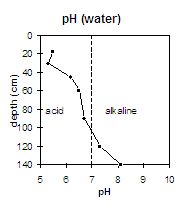 | The surface (A) horizons are strongly acid. The upper subsoil is moderately acid and pH increases with depth. The deeper subsoil is alkaline. | 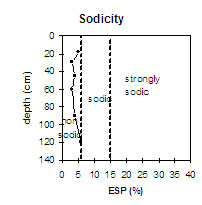 | The upper metre of the soil profile is non-sodic and non-dispersive. The lower horizons are marginally sodic. |
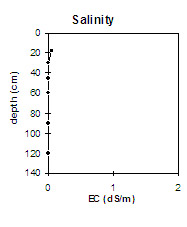 | There is a very low level of soluble salts throughout the soil profile. | 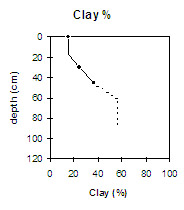 | There is a lack of strong texture contrast between the surface (A) horizons and the clayey subsoil. |
Horizon | Horizon Depth (cm) | pH (water) | pH (CaCl2) | EC 1:5 | Exchangeable Cations | Exchangeable Aluminium mg/kg | Field Capacity pF 2.5 | Wilting Point pF 4.2 | Coarse Sand (0.2 - 2 mm) | Fine Sand (0.02 - 0.2 mm) | Silt (0.002 -0.02 mm) | Clay (<0.002 mm) | |||
Ca | Mg | K | Na | ||||||||||||
meq/100g | |||||||||||||||
A1 | 0-18 | 5.5 | 4.7 | 0.06 | 2.4 | 0.61 | 0.38 | 0.17 | 18 | 26 | 6 | 11 | 51 | 23 | 15 |
A1 | 18-30 | 5.3 | 4.3 | <0.05 | 2.4 | 0.75 | 0.3 | 0.09 | 44 | 22 | 7 | 11 | 47 | 21 | 24 |
B21 | 30-45 | 6.2 | 5.4 | <0.05 | 3.9 | 2.1 | 0.27 | 0.21 | 24 | 10 | 11 | 38 | 17 | 36 | |
B22 | 45-60 | 6.5 | 5.6 | <0.05 | 5.1 | 4.3 | 0.53 | 0.25 | 31 | 16 | 7 | 26 | 12 | 56 | |
B23 | 60-90 | 6.7 | 5.8 | <0.05 | 5.2 | 4.8 | 0.73 | 0.41 | 29 | 17 | |||||
B24 | 90-120 | 7.3 | 6 | <0.05 | 4.8 | 6.1 | 0.72 | 0.67 | |||||||
B3 | 120+ | 8.1 | 6.7 | <0.05 | 5.2 | 7.3 | 0.66 | 0.97 | |||||||
Management Considerations:
Whole Profile
- Plant available water capacity (PAWC) is considered to be low (estimated at 90 mm) for the top metre of this soil profile. This is based on available laboratory data.
- The surface horizon has a high fine sand (50%) and silt (23%) content. These soils rely on organic matter to maintain soil aggregation and prevent slaking. The organic carbon value for this pit site is relatively low (1.1%). Organic matter levels will build up under pasture but will decline if cropping takes place. Practices such as residue retention, minimum tillage and pasture rotations should be utilised if cropping takes place.
- The upper subsoil horizons are non-sodic and non-dispersive. This, together with the lack of a strong texture contrast at the A/B horizon boundary, indicates that water and root movement will not be significantly restricted.
- The large amount of manganiferous segregations in the deeper subsoil i.e. from 90 cm depth may have a toxic effect on deeper rooted manganese sensitive species.
- Ploughed in 1969 and disc cultivated in 1985.
- Sowed seed plots in 1983.


